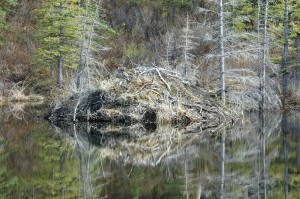December comes, the dark month on the heels of November’s lightedness; it’s the month when we string trees with winking reminders, when we hang reflecting globes from branches, anything to shed or catch a little light. And as I walk out along the river or into the woods, I find myself wondering about all the life that’s gone to ground, that rests or sleeps as I walk by.
In Estabrook Woods, I pause along the trail that passes Stump Pond, and through the leafless trees, on its far side, I see the gray hump of the longstanding beaver lodge; I wonder if a next generation still lives there, and, if they do, what today’s like under that woody dome.
All of this puts me in mind of Donald Griffin, prominent 20th-century scientist and Lexington resident, who died a decade or so ago. One day, while ambling in these woods, I’d come across the unusual sight of a car backed down close to the edge of Stump Pond. I’d broken off from my path to have a look. There, rooting around in the back of his station wagon, I’d found an older man with clear eyes and a bristling brush cut of gray hair.
“I bet you wonder what I’m doing,” he said.
“Um, yes,” I answered. “I’ve never seen a car here.”
“Ah,” he said. “I’ve gotten too old to lug all my gear in here, so the school [Harvard University owns and manages the core of these woods as research field station] let’s me drive this far in for my research. I bet you want to know what that research is,” he said.
“Well, yes,” I answered.
“Take a look,” said Griffin, gesturing to the small screen of a compact laptop, and he pressed return. A small beaver appeared on the screen, and it was clear he was inside some woody structure. Before the beaver, there was a dark patch of water, and suddenly from it came a much larger beaver.
“That’s the mother,” said Griffin. “Now, watch this.” First, there was a moment of what seemed to be disagreement between the two beavers; then, without pause, the mother seized the little beaver with both forepaws, lifted him and ducked him under the water, holding him there for long seconds. When she lifted the small beaver out, he squalled and pawed the air in protest. Mother was having none of that and plunged her child back under water; I counted to ten and whispered, “Whoa, how long’s she going to keep him under?”
“Pretty remarkable, eh?” said Griffin. “Must be some sort of training going on here.”
Griffin was an early crosser-of-scientific lines, venturing into the territory of animal consciousness when most of his stiff-minded peers saw such speculation as Science’s equivalent to literature’s pathetic fallacy, wherein supposedly pathetic writers see all sorts of evidence for human awareness in natural phenomena. Consciousness, the ability to think about your thought and life, to mull over its past and plan for its future, was, for most scientists, deemed an exclusively human province. “Perhaps not,” said Griffin, and here in his late 80s he was still filming and analyzing animals for deeper signs of this consciousness and so their nearer kinship with us.
“Kind of makes you think there’s a lot going on under that dome, don’t you think?” said Griffin, pointing to the gray humped mass of a beaver lodge across the pond.
“How’d you get those pictures?” I asked, and Griffin’s face wrinkled with a smile; he settled in to what seemed to be a favorite story. The vertical jut of what turned out to be a pole rose from the lodge, and Griffin told me that it was a pipe he’d inserted carefully into the lodge; down the pipe’s throat he’d slid an infrared camera, and, after a short period of acclimation, he’d noticed that the beavers paid the pipe and camera no attention. Here then, to Griffin’s knowledge, were the first unsullied, recorded actions of beavers inside their lodge; here was raw footage that might cast more light on his central question.“Well, that sure looks like the mother’s thought out what she’s doing,” I said straightening from watching the screen and feeling my cooled muscles protest.
A few minutes later, I was on my way back to town and its knit of work and thought, but burred to me were Griffin’s images and story.
Today, as I walk along, whether the domes I see are heads or beaver lodges or simply bumps of earth, I’m guessing that even in dark December there is a lot going on inside. Memory’s mind is also a lodge into which we like to peer, looking for signs of its order and our intentions.


